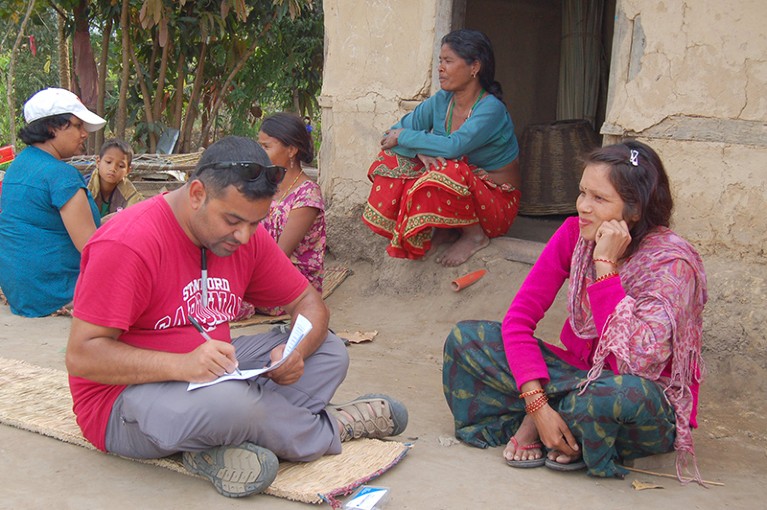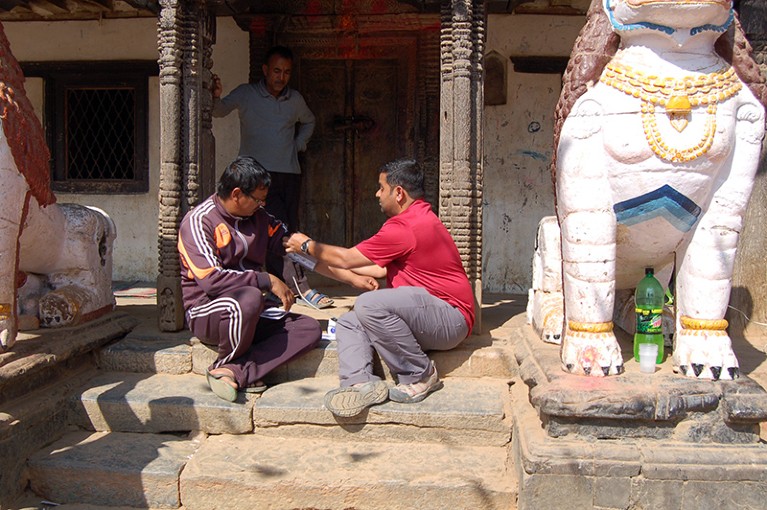
Aashish Jha combines gut-microbiome research with public-health advocacy work in remote communities in far-western Nepal.Credit: Aashish Jha
Pursuing his PhD at the University of Chicago in Illinois, Aashish Jha loved the idea of examining fossilized bones using modern genetic tools. During his postdoctoral research at Stanford University, California, Jha narrowed his focus to look for patterns of evolution in living entities — studying how lifestyle changes affect the bacterial colonies living in the human gut.
In early 2016, he travelled to remote terrains in far-western Nepal to collect faecal samples from forager communities that had recently transitioned to a farming lifestyle, so that he could sequence their gut microbiomes. But the experience left him with mixed feelings about his research focus. He saw the harsh daily realities faced by these communities, many of which have limited access to health care and education. Furthermore, inadequate infant and maternal health care often led to stunting, a condition in which children do not reach their full growth potential.
Link Creating a paper device to improve public health in Nepal
Seven years later, as a population geneticist at New York University Abu Dhabi in the United Arab Emirates, Jha continues working with rural and marginalized Nepalese communities, but with a focus on applied research that has translational value for the communities. With support from the Bill & Melinda Gates Foundation, based in Seattle, Washington, he is examining how stunting manifests in distinct environments in various communities. Jha tells Nature how his research group is integrating fieldwork with broader social-health initiatives and advocacy efforts, and how he balances the roles of researcher and public-health advocate.
What is the relationship between the gut microbiome and stunting in children? How does your research track this?
In 2016, scientists discovered that malnourishment can alter the bacterial colonies living in the guts of children, which can then contribute to conditions such as stunting. As a result, researchers are searching for prebiotics and dietary supplements to improve microbiome deficiencies linked to stunting. However, these supplements might not be effective for all children, because microbiomes vary depending on a child’s environment.
Our research focuses on studying infants born in urban, semi-urban and foraging communities to determine whether stunting follows different trajectories in different environments. This will help us to identify whether stunted forager children have varied prebiotic requirements and need personalized interventions.
You trained as a basic scientist and now you work on applied research. How did you make that transition?
When I started, I didn’t have specialized knowledge in microbiome research, metagenomics or their statistical analysis, so I had to reach out to colleagues.
We built a science institute from scratch
After my first field visit to Nepal to collect stool samples in 2016, I needed to sequence them — but my own department at Stanford lacked facilities for large-scale metagenomics. So, I reached out to other researchers, including Justin Sonnenburg, a microbiologist at Stanford who was leading another gut-microbiome project among the Hadza people in Tanzania, a hunter-gatherer tribe. Sonnenburg saw the potential for my samples to serve as a reference point for his group’s work. We decided to collaborate: my samples were sequenced in his laboratory and he served as my mentor. Later that year, when the Gates Foundation contacted Sonnenburg about investing in microbiome projects focusing on infant health in low-income countries, he reached out to me again as a collaborator.
What is your team working on now?
We are focused on collecting stool samples from pregnant mothers and first-year infants from marginalized communities in central Nepal. We have recruited and trained local nurses from the same communities. They collect stool samples from pregnant mothers in each trimester, and also from the babies — six times during the first three months of their lives, followed by monthly collections until they are one year old. We can detect the pattern of microbiome-related stunting within the first three years.

Population geneticist Aashish Jha collects data from a research participant in Lalitpur, Nepal.Credit: Aashish Jha
The nurses also aid community health clinics, which are severely underfunded in Nepal. And they connect with volunteer groups to help educate local people on hygiene, infant care, malnutrition, maternal care, menstrual health and teen marriage.
How did your team find and train local nurses to help with your research?
The locals are more receptive to people from their own communities. We searched for local nurses for more than three months and hired ones from communities including the Chepang, Maithili and Danuwar peoples, and from Nepalese Muslims.
During a two-day workshop in Kathmandu, we trained them about the purpose of the research, the basics of the gut microbiome, stool-sample collection and safety precautions. Importantly, we also taught them how to use liquid nitrogen to freeze stool samples during household visits.
Why did you feel the need to incorporate a social angle into your microbiome research?
The link between gut-microbiome changes and stunting in children is just one piece of a larger puzzle. Many factors — such as malnutrition, teen pregnancy, poor prenatal and postnatal infant care, unhygienic habits and infections — influence the gut microbiome. Although microbiome research might take several years to yield conclusive results, such social initiatives can provide immediate benefits by increasing awareness in the community.
As someone from outside these communities, how has collaboration with other organizations helped your research?
The COVID-19 pandemic delayed our fieldwork by more than a year. However, this allowed us to proactively seek out collaborators. We looked for organizations that had previously done public-health work in those communities and decided to partner with a network called Integrated Rural Health Development Training Center Nepal, which helped in finding and training local nurses.
How a failed eczema treatment triggered an interest in traditional medicine
When we had challenges finding pregnant mothers, we also reached out to the Female Community Health Volunteer network, a government initiative in which local female leaders train women on reproductive health, and on maternal and child health care. Because pregnant women in these communities often shy away from discussing pregnancies until a later stage, this group was crucial in identifying pregnant women and convincing them to enrol in the study early on.
How can researchers ensure that the populations they study also benefit from the research?
Researchers who study marginalized communities should find a way to give something back to society. It could be knowledge sharing, educational empowerment or sharing products such as prebiotics or supplements.
In our second extension of this work, we are planning for a stronger socio-economic focus. Because many problems stem from a lack of education, we are giving scholarships (of about 1,000 Nepalese rupees or US$7.50 per month) to the families of 16 talented girls from these communities, so that they get a small incentive to send their daughters to school. The girls learn the basics of microbiome research, hygiene and reproductive health from our field nurses, and are able to influence their peers.
Personally, it would be a remarkable achievement for me, if girls from these communities continued to flourish and if, at some point, I get to train some of them in my lab at NYU Abu Dhabi.

 Link Creating a paper device to improve public health in Nepal
Link Creating a paper device to improve public health in Nepal
 We built a science institute from scratch
We built a science institute from scratch
 How a failed eczema treatment triggered an interest in traditional medicine
How a failed eczema treatment triggered an interest in traditional medicine







